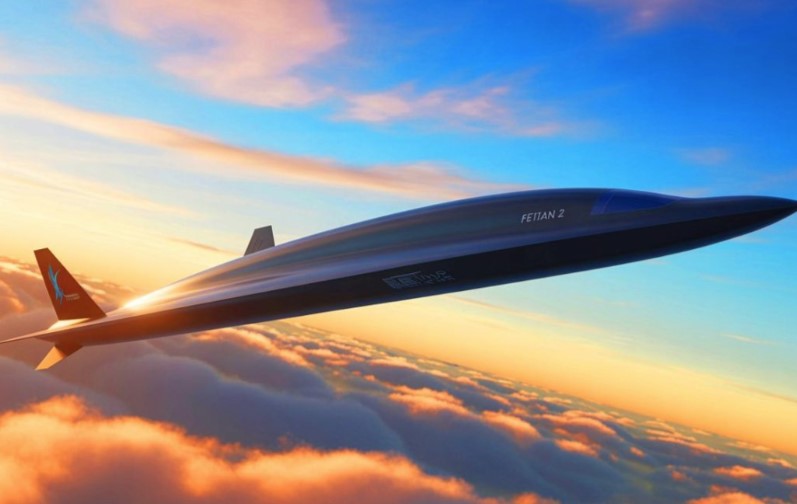In northwest China, China successfully tested the Feitian 2, a new hypersonic vehicle. This test marks a major step forward in high-speed flight technology.
Hypersonic Leap: Feitian 2 Flies Faster and Smarter
Feitian 2 is not an ordinary aircraft. It can fly at hypersonic speeds. That means it goes more than five times faster than the speed of sound. What makes it truly special is its engine system. It can switch between two types of engines while flying.
The Feitian 2, which made its first flight in 2022, is an upgraded version of the Feitian 1. To make Feitian 2 lighter, faster, and more efficient, scientists have been working on the design and engine system for years.
The most important part of this hypersonic vehicle is its Rocket-Based Combined Cycle (RBCC) engine. This engine is a powerful and smart system that can work both like a rocket and like a jet engine. At takeoff, it works like a rocket, pushing the vehicle upward quickly. Once Feitian 2 flies fast and high, its engine changes mode. It switches to a jet-like engine. This engine uses air from the atmosphere. It burns fuel more efficiently this way.
Could the World Stop Them? China’s Hypersonic Swarm Drones Evade Radar, Overwhelm Defenses
The vehicle saves weight by not carrying too much oxygen. It also uses less fuel during flight. In the test, Feitian 2 smoothly switched between engine modes in midair.
Smart Engine in Feitian 2: No More Heavy Oxygen Tanks
Kerosene and hydrogen peroxide are used to power the Feitian 2, which is a wise decision that gives the car both strength and safety. Many other hypersonic aircraft use cryogenic fuels, such as liquid hydrogen or liquid oxygen, which must be kept extremely cold. These fuels require special storage systems and can add a lot of weight to the vehicle.
Feitian 2 avoids these issues by using kerosene, which is easier to store and handle. Even though kerosene does not produce as much energy as liquid hydrogen, it is lighter and safer, and it still performs well at very high speeds.
China Willing to Revisit Tariffs, Subsidies in WTO Negotiations with US
To make kerosene burn efficiently without carrying large oxygen tanks, the vehicle uses hydrogen peroxide as an oxidizer. This chemical helps the kerosene ignite more easily and provides steady and reliable thrust at high speeds. Hydrogen peroxide is easier to store than liquid oxygen and does not require extremely low temperatures.
This fuel combination not only reduces the overall weight of the vehicle but also makes it easier to control and operate during flight. The success of this fuel system during the test flight shows that Feitian 2 is built for real-world performance, not just lab experiments.
Self-Flying and Aerodynamic: Built for Stability at Extreme Speeds
Feitian 2 doesn’t just fly fast — it also flies on its own. The test showed that the vehicle can change its flight angle and direction by itself, depending on the weather and the air around it. This means the vehicle can stay stable and in control even while flying at extremely high speeds and altitudes.
The latest version of Feitian 2 has been improved with larger tail fins and extra wings near the front. These changes help keep the vehicle balanced and easier to steer in the air. Aerodynamic control is very important at hypersonic speeds, as the air behaves differently when an object moves faster than the speed of sound.
During the flight test, the RBCC engine also showed that it could adjust the amount of air it takes in, depending on the vehicle’s speed and altitude. This smart air management system helps the engine perform better and keeps the flight smooth and steady.
The launch sequence followed a clear process. This hypersonic vehicle took off using rocket power — this stage is called ejector mode. Once it reached a high speed, the engine switched to ramjet mode, where it used oxygen from the air. This is a tough technical task, but Feitian 2 did it without any issues.
China Revives a Forgotten U.S. Dream — Hypersonic Engine Burns for 2.2 Seconds That Shook the World
This success proves that China has made major progress in RBCC engine technology. The country is now one of the few in the world to show real results in this advanced field. With its ability to fly long distances quickly, switch engines mid-air, and operate without a pilot, Feitian 2 has opened new doors for hypersonic vehicles.
These capabilities make Feitian 2 suitable for both defence and scientific purposes. It shows how smart design, clever fuel choices, and advanced engine technology can come together to build a high-performance hypersonic system.

